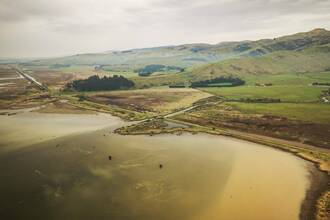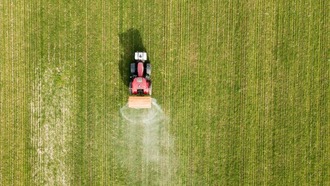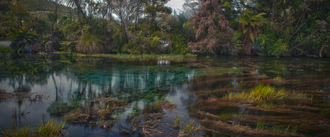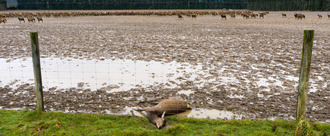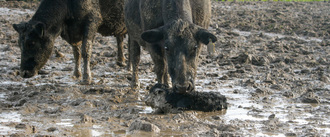-
Otago Regional Council: Phase Out Synthetic Nitrogen FertiliserSynthetic nitrogenous fertiliser should be banned because: 1) It pollutes our rivers and lakes 2) It allows the establishment and growth of intensive dairy farming in inappropriate places in Otago 3) It causes the release of nitrous oxide, one of the worst greenhouse gases 4) There is evidence nitrates cause bowel cancer 5) It is degrading the natural health of our soils Our once-safe drinking water is being contaminated. Everyone needs safe drinking water and clean swimmable rivers. Too many cows made possible by too much chemical fertiliser are polluting the once pristine rivers and lakes of the Central Otago. Agriculture causes 48% of all our greenhouse gas emissions and overloads our rivers with synthetic nitrogen in the form of nitrates. The 2019 report The Hidden Killer, compiled by the world’s leading climate scientists, documents the impacts of wealthy countries failing to make the changes needed to ensure liveable futures. New Zealand’s circumstances require us to tackle our biggest polluter, industrial dairy farming. Current research shows a strong link between nitrates in drinking water and babies being born underweight or prematurely.[1] Chronic exposure to drinking water containing more than 0.88 mg/L of nitrogen in the form of nitrates has been linked to colorectal cancers.[2] Synthetic nitrogenous fertiliser is mostly sold here by just two companies; Ravensdown and Ballance. Industrial dairying is their biggest customer by far. A transition away from industrial livestock farming and mass milk production is essential. A ban on synthetic nitrogenous fertiliser and a nationwide shift to more plant-based regenerative organic farming is urgent and essential. Our Regional Council has the responsibility for environmental management, monitoring, enforcement and compliance, and has the power to end synthetic nitrogenous fertiliser use. We call on the ORC to put te Mana o te Wai (the integrity of the waters) first, so that all other objectives in the Regional Policy Statement are informed by the priority to care for water and keep it healthy. Synthetic nitrogenous fertiliser use is incompatible with te Mana o te Wai. Join the call! Add your name today to demand our Councillors immediately put in place a swift, fair phaseout of synthetic nitrogenous fertiliser. Free mail-in nitrate water testing for drinking water, from private bores only: https://petition.act.greenpeace.org.nz/agriculture-nitrate-testing-request Image: Geoff Reid https://geoffreidnz.com References 1 - Link between nitrate levels and premature births, study finds, 2021https://bit.ly/3vacKKK 2 - Report: The hidden killer, 2019. How synthetic nitrogen fertiliser is fuelling intensive dairying, polluting our rivers and climate. https://www.greenpeace.org/static/planet4-aotearoa-stateless/2019/09/8130950a-greenpeace-synthetic-nitrogen-fertiliser-briefing.pdf372 of 400 SignaturesCreated by Rosemary Penwarden
-
Phase out synthetic nitrogen fertiliser - SouthlandSynthetic nitrogenous fertiliser should be banned because: 🌏 It pollutes our rivers and lakes 🌏 It is responsible for the growth of intensive, unsustainable farming 🌏 It causes the release of nitrous oxide, one of the worst greenhouse gases 🌏 It is a likely cause of bowel cancer 🌏 It is degrading the natural health of our soils Everyone deserves safe drinking water and clean rivers to swim in. But too many cows, and too much chemical fertiliser, are rapidly polluting the rivers, lakes and drinking water we should all be able to enjoy and rely on. The agriculture sector is currently Aotearoa New Zealand’s biggest polluter, causing 48% of all our greenhouse gas emissions, and overloading our rivers with synthetic nitrogen in the form of nitrates (nitrogen). Southland’s cow numbers have increased by 16 times since 1990, from 38,000 to 636,000 and according to Stats NZ we have nationally increased the tonnes of nitrogen fertiliser applied to farmland per annum by 629 per cent from 1991 to now (from 62,000 tonnes to 452,000 tonnes). Our once clean rivers and lakes are increasingly polluted. Our once-safe drinking water is being contaminated. A 2019 report found nitrate was the contaminant with the highest risk ranking in Southland’s groundwater. Growing research is showing a strong link between nitrate in drinking water and babies being born underweight or prematurely.(1,2) Chronic exposure is associated with formation of carcinogenic nitroso compounds in the gastrointestinal tract. Chronic exposure through drinking water containing > 0.88 mg/L (as nitrate-N) has recently been linked to colorectal cancers. (1,2) It’s shocking that Southland has to build a Charity Hospital to deal with the large number of colonoscopies needed by people from across Murihiku Southland which the current Southland Hospital does not have the capacity to deal with. Synthetic nitrogenous fertiliser is mostly sold here by just two companies; Ravensdown and Ballance have industrial dairying as their biggest customer by far. A transition away from industrial livestock farming and mass milk production is required. It starts with an urgent ban on synthetic nitrogenous fertiliser, and a nationwide shift to more plant-based regenerative organic farming. Our Regional Council has the responsibility for environmental management, monitoring, enforcement and compliance, and has the power to end synthetic nitrogenous fertiliser use. Join the call! Add your name today to demand our Councillors cut synthetic nitrogenous fertiliser. Also you can request free nitrate testing for private bores if you wish to have peace of mind that your own water supply is safe: https://petition.act.greenpeace.org.nz/agriculture-nitrate-testing-request References 1 - Link between nitrate levels and premature births, study finds, 2021 https://bit.ly/3vacKKK 2 - Human health risks associated with contaminants in Southland waters, 2019 https://bit.ly/3sjB5f2 3 - Report: The hidden killer, 2019. How synthetic nitrogen fertiliser is fuelling intensive dairying, polluting our rivers and climate. https://www.greenpeace.org/static/planet4-aotearoa-stateless/2019/09/8130950a-greenpeace-synthetic-nitrogen-fertiliser-briefing.pdf146 of 200 SignaturesCreated by Jenny, Dave and Robina
-
Stop the proposed cattle feedlots in Te Waihora (Lake Ellesmere) - Ōtautahi★ 16 June 2022: The Little River ECO-Collective gathered in front of ECAN, the head offices of Environment Canterbury in Christchurch, to present the 2 petitions huge 2000-cattle feed barn with well over 3000 signatures. Green MP Eugenie Sage and Labour MP Tracey McLellan will attend the event in support. Please continue to help build the pressure to put this issue on the agenda. Write to ECAN to express your concern about the lack of appropriate action – ask ECan to make the Wongan Hills feedlot application ‘publicly notifiable’, and involve us in the decision making: email Chief Executive of ECan: [email protected] ★ Te Waihora (Lake Ellesmere) is the largest lake in Canterbury/Waitaha and one of the most important wetland habitats in New Zealand, providing homes for numerous birds, plants and invertebrates. Yet it’s also heavily polluted from the runoff of surrounding farms with some of the country’s highest concentrations of sediment, nitrogen and phosphorus. Over-allocation of water to irrigation schemes contributes to the problem. It could get much worse with a proposal for industrial farms and thousands of cattle right on its shores. Christchurch City Council has granted consent for company Wongan Hills to build two 200m-long indoor barns, or feedlots, holding up to 1000 steers each, raised for beef, in Kaituna Valley, Banks Peninsula. The sheds breach several district plan rules, including those for maximum building footprint which is meant to be 300m². The barns and buildings will cover 24,330m². These proposed feedlots to be installed on Te Waihora land are utterly unacceptable. The lake already suffers enormously from pollution from current farming practices. Feedlots are a style of intensive indoor farming that is focused on increased production from animals, in larger numbers, in smaller spaces. Feedlots risk spreading disease and the huge amounts of waste pollute waterways, soil and plant life. Animal farming is responsible for a large part of New Zealand’s greenhouse gas emissions and these intensive feedlots do not align with the way Aotearoa should be responding to the current climate crisis. This kind of intensive farming has no place in Aotearoa, and especially Canterbury. We should be moving to regenerative and organic agricultural systems that work with the environment, not against it. We strongly oppose this and call on the Council to throw it out immediately. There should be no chance of a consent from Environment Canterbury. [Image: Stuff] Controversial farmer’s next venture: A feedlot https://www.newsroom.co.nz/pro/controversial-farmers-next-venture-a-feedlot Whakaora Te Waihora https://ngaitahu.iwi.nz/environment/te-waihora/whakaora-te-waihora/ Land, air, water Aotearoa - Te Waihora/Lake Ellesmere water quality https://www.lawa.org.nz/explore-data/canterbury-region/lakes/te-waihoralake-ellesmere/#:~:text=Average%20water%20quality.,Mesotrophic%20lake%20conditions. How to fix Te Waihora/Lake Ellesmere https://www.nzgeo.com/stories/how-to-fix-te-waihora-lake-ellesmere/ Why you should give a damn about feedlots https://thespinoff.co.nz/food/23-08-2018/why-you-should-give-a-damn-about-feedlots2,086 of 3,000 SignaturesCreated by Annelies Pekelharing
-
Cut synthetic nitrogen fertiliserTogether we are facing enormous challenges to our local ecosystems and climate. Our food production systems need to be resilient and sustainable to guarantee a long term future. Everyone deserves to swim in clean rivers and have safe drinking water. But too many cows and too much chemical fertiliser is rapidly polluting the rivers, lakes and drinking water we should all be able to enjoy and rely on. The agriculture sector is currently Aotearoa New Zealand’s biggest polluter, causing 48% of all our greenhouse gas emissions, and overloading our rivers with nitrate nitrogen. Synthetic nitrogen fertiliser is the key ingredient that has intensified agriculture in Aotearoa, in particular dairy farming. Since 1990, dairy cow numbers have doubled. The addition of synthetic nitrogen fertiliser on the land has increased seven-fold. Dairy farmers spread synthetic nitrogen fertiliser onto farmland in vast quantities because in the short term it’s an easy way to make grass and other crops grow fast. Synthetic nitrogen fertiliser is a double whammy for the climate. Its use enables increasing numbers of cows on the land, which increases methane gas emissions from burps, and more nitrous oxide emissions from manure and urine. Nitrous oxide is one of the most dangerous greenhouse gases. It’s 265 times worse for trapping heat in the atmosphere than carbon dioxide. Synthetic nitrogen fertiliser is mostly sold here by just two companies; Ravensdown and Ballance and industrial dairying is their biggest customer by far. Besides our climate, our once clean rivers and lakes are increasingly polluted. When nitrogen gets into rivers and lakes it can cause algal blooms which can suck all the oxygen out of the water, suffocating fish and other species. Our once-safe drinking water is becoming contaminated. Entire freshwater ecosystems are being pushed past breaking point. We are on the brink of losing native freshwater species forever. A transition away from industrial livestock farming and mass milk production is required. It starts with an urgent ban on synthetic nitrogen fertiliser, and a nationwide shift to more plant-based regenerative organic farming. Regenerative organic farming is a way of growing food that works with nature. Instead of using synthetic nitrogen regenerative farmers use nitrogen fixing plants and put their effort into building healthy soil. They farm a diverse mix of crop and animal varieties, and use methods like cover cropping, inter-cropping, agro-forestry, and no-till techniques. Together, we can move towards regenerative organic farming. But first, we need to starve Big Ag of its key ingredient. The Government has set new rules for fresh water which limit the amount of nitrogen fertiliser farmers can use, but still leave the limit too high. Our Regional Council has the responsibility for environmental management, monitoring, enforcement and compliance, and has the power to cut synthetic nitrogen fertiliser use. Join the call! Add your name today to demand our Councillors cut synthetic nitrogen fertiliser. https://www.instagram.com/cutsnfcanterbury/ Report: The hidden killer, 2019. How synthetic nitrogen fertiliser is fuelling intensive dairying, polluting our rivers and climate. https://www.greenpeace.org/static/planet4-aotearoa-stateless/2019/09/8130950a-greenpeace-synthetic-nitrogen-fertiliser-briefing.pdf Agriculture emissions and climate change 2021 https://environment.govt.nz/guides/agriculture-emissions-climate-change/ Why New Zealand has to cut synthetic nitrogen fertiliser https://www.youtube.com/watch?v=arc73-E5W9M The Regenerators https://www.youtube.com/watch?v=OKMM2b6srIg1,459 of 2,000 SignaturesCreated by Krysta Neve
-
Give cows a life worth livingThere are over six million dairy cows in New Zealand. They are literally everywhere across our landscape as farming has intensified. A more sustainable future that is kinder for cows and truly gives them a good life, a life worth living, must include a transition to more plant-based regenerative agriculture, and that's better for the planet too. Our animal welfare laws establish animal sentience as a basis for how we treat farmed animals.(1) This means we recognise cows feel pain. They think, have physical and social wants and needs, including food, water and shelter, and the company of (cow) friends and family, just like us. They are peaceful, generous herbivores but we’re exploiting them for profit. Our laws also recognise the need for 'a good life for cows' as a basic measure of welfare. This means they must have food and shelter. But they also need, and deserve, 'a life worth living' - with friendship, enrichment – a variety and things of interest, and ‘positive affective states’ - happiness, too.(2) Yet dairy cows have anything but a good life and a life worth living.(3) Since the 1990s the dairy industry has squeezed cows more closely together for higher production. Cows are exposed to the harsh weather because shelterbelts were removed to fit in more cows. Intensive winter grazing can see cows crammed in at two per metre (!) and forced to sleep and give birth in mud.(4) All calves are taken from their mothers at around four days old, and around two million of them are killed outright either at the slaughterhouse or on-farm. At least a quarter of the herd is also 'replaced' - killed, every year. And that's mostly for milk, butter and other dairy products, 96% of which get sent overseas. We make so much money from cows in Aotearoa, we're living on the cows' back. The least we can do is ensure they have lives worth living in this Code of Welfare review. Ultimately, cows deserve to live in a world in intact family units where they are not exploited and killed for their bodily products. We have the power to shape a genuinely good life for cows and ensure they have a life worth living, in the 2022 Government review of the dairy cow Code of Welfare. Let’s do it. [1] Animal sentience: https://www.mpi.govt.nz/animals/animal-welfare/national-animal-welfare-advisory-committee/animal-sentience-their-emotions-feelings-and-experiences-of-life/ (2) https://www.ncbi.nlm.nih.gov/pmc/articles/PMC4810049/ (3) https://www.stuff.co.nz/business/farming/125319128/animal-welfare-complaints-increasing-in-dairy-industry (4) https://www.mpi.govt.nz/dmsdocument/38210/direct375 of 400 SignaturesCreated by Christine Rose
-
Increase water flow on Manuherikia RiverNew Zealand law stipulates a responsibility to protect and improve the health of our waterways. The role of the Otago Regional Council is to implement this policy. For too long, private profit-driven imperatives have exploited our fresh waterways, including the Manuherikia River. These have taken precedence over environmental guardianship and the legacy we leave to future generations. This has led to extreme degradation of the river including loss of biodiversity and habitat due to river levels dropping to the extreme, largely due to agricultural and horticultural irrigation through water allocations and the exploitation of water rights attached to historical gold-mining permits. We are well aware of the contribution farming makes to New Zealand’s economy. However, we are also well aware that the financial costs of environmental degradation caused by predominant farming practices, are never included in the financial equation. These costs will be borne by our children and grandchildren. (Mike Joy https://www.rnz.co.nz/news/on-the-inside/440120/polluted-waterways-why-are-we-subsidising-environmental-harm) Rather than posing river health and farming in an adversarial context, the better question to ask and explore is: what forms of farming are best aligned to optimum river health? Examples abound here in New Zealand and overseas (particularly Australia/see Charles Massy) of low input farming practices suited to dry land, drought-prone regions which are both sustainable and profitable, that maintain and improve soil health and structure, leading to improved water holding capacity, a decrease in soil erosion, and minimising the need for irrigation. (see also Alan Savory, James Rebanks, Bill Mollison, Masanobu Fukuoka to name a few). Such regenerative and organic approaches to land and resource management prove that environmental guardianship is entirely possible and can be compatible with agriculture and horticulture. The predominant extractive farming model is not sustainable in the short-term, and certainly not in the long-term. As responsible citizens, we must acknowledge that nature has limits, but within those limits, there is an abundance of space for innovative, visionary and long-term practical land and water use.173 of 200 SignaturesCreated by Water Watch Otago
-
Save Te Waikoropupū Springs from the threat of synthetic nitrogenTe Waikoropupū Springs are a national and international taonga (treasure). The springs have some of the clearest water ever measured on earth. That clarity is under threat from rising nitrate pollution - the signature of industrial dairying. The main source of the pollution is dairy farms in the recharge area of the aquifer, which apply hundreds of tonnes of synthetic nitrogen fertiliser each year, mainly urea. For over three years Golden Bay volunteers have meticulously monitored nitrate levels at the Springs. The undeniable trend is upward. By September 2019 the levels were 30% up from 2016 - and rising. Increasing nitrate levels are a threat to the unique ecosystem of Te Waikoropupū Springs. Elevated nitrate levels create ideal growing conditions for ugly algal blooms and pond slime. Recently a mat of ‘filamentous green algae’ was observed by DOC at the Dancing Sands Spring. This contaminant is typically found in nitrate rich waters. Rising nitrate levels also threaten the tiny creatures (stygofauna) that create the sparkling clear water in the aquifer. Te Waikoropupū Springs are of immense cultural, ecological and spiritual importance to New Zealanders. They are a Wāhi Tapu (Sacred place) to Māori. They are visited by more than 90,000 people a year. The upward trend in nitrate readings is a call to urgent action! We the undersigned ask that Minister for the Environment David Parker and the New Zealand Government acts urgently to ban synthetic nitrogen fertiliser from the recharge area of the Arthur Marble Aquifer.17,746 of 20,000 SignaturesCreated by Kevin Moran
-
Stop Intensive Winter Grazing: Get animals out of mud on our Pāmu farms and save our riversPāmu (AKA Landcorp Farms) belongs to all New Zealanders and we, the public, are all stakeholders with a right to say what is done on our behalf. Intensive Winter Grazing (IWG) is cruel to animals, it’s polluting our rivers, streams, estuaries and groundwater, and it is damaging the reputation of Aotearoa New Zealand. The practice of confining large numbers of animals into a small area over winter churns paddocks to a deep slurry of mud, faeces and urine. The toxic runoff pollutes our waterways and kills freshwater life in rivers and estuaries. As well as pollution, there are serious animal welfare problems associated with the practice as this recently released graphic footage of cows being forced to give birth in the freezing mud shows. There are better ways to farm. Pāmu should lead by example, end intensive winter grazing and shift to less intensive land use. Pāmu can do this and still make money - their own modelling proves it. This practice is very stressful on individual Pāmu farm managers and staff. Taking the pressure off them will improve wellbeing and mental health. More Information: Freshwater pollution: Nitrate leaches into our aquifers at up to 10 times the rate of normal grazing, destroying groundwater for future use and remaining for hundreds of years. Phosphate and pathogen-rich effluent runs off into streams, rivers, lakes and estuaries, making them unswimmable, and killing ecosystems. Animal suffering: When it rains the land on which these animals are grazed turns to mud, leaving heavily pregnant mothers with nowhere dry to rest and give birth. They get exhausted and end up drinking muddy water to hydrate. Dry paddocks are often full of boulders which are painful to stand on. Soil degradation and loss: IWG destroys the soil and releases tonnes of stored carbon into the atmosphere, accelerating climate breakdown. It’s practice is heavily dependent on pesticides, herbicides and synthetic fertilisers which are causing severe decline in biodiversity and human health. It’s also the cause of huge loss of valuable topsoil. #EndIntensiveWinterGrazing1,179 of 2,000 SignaturesCreated by Geoff Reid

-
End all NZ Super Fund Investments in Intensive Winter GrazingOur nation’s global reputation relies on a government that puts the health of its environment and people's wellbeing first. Spending millions of dollars from the nation’s pension fund on farms that practice Intensive Winter Grazing is one of the most unethical choices the Superannuation investment fund has EVER made! In contrast to traditional grazing, Intensive Winter Grazing restricts animals to small patches of land for long periods, which quickly turn into mud. This practice causes freshwater pollution, animal suffering and soil degradation. Freshwater pollution: Nitrate leaches into our aquifers at over 10 times the rate of normal grazing, destroying groundwater for future use and remaining for hundreds of years. Phosphate- and pathogen-rich effluent runs off into streams, rivers, lakes and estuaries, making them un-swimmable, and killing ecosystems. Animal suffering: The land these animals are grazed on turns to mud, which leaves animals with nowhere dry to rest and give birth. They often end up licking mud to get water. Soil degradation: Intensive Winter Grazing destroys the soil and releases tonnes of stored carbon into the atmosphere, accelerating climate breakdown. This practice is heavily dependant on pesticides, herbicides and synthetic fertilisers which are causing severe decline in biodiversity and human health. This is no way to be ‘investing for the next generation’. Please sign and share this petition with your networks Email the minister responsible: Hon Grant Robertson, Minister of Finance. [email protected] Tell him to; Stop investing any of the New Zealand Super Fund into farms that are winter crop grazing, divest from any that continue, and find sustainable alternatives immediately! #EndIntensiveWinterGrazing7,452 of 8,000 SignaturesCreated by Geoff Reid




